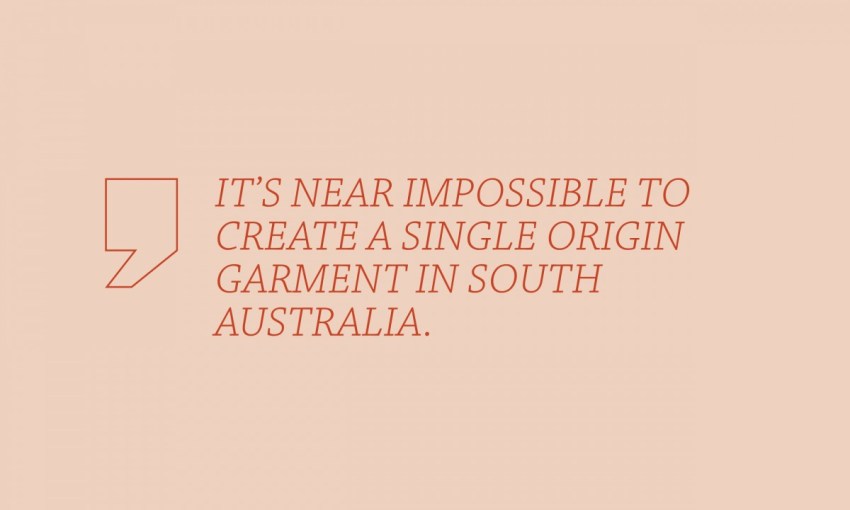Sharmonie Cockayne's Omi knew things about fashion that only a rare few in Adelaide's growing industry will ever get the chance to learn.
Why ‘Made in Adelaide’ is a fashion rarity
My Omi (the German word “granny”) and her family fled Lithuania during World War Two. When she arrived in Australia in 1948, she was twelve. She had no skills.
For the next six years, she went to school where she was taught the skills necessary to live and contribute to society as it was back then.

Sharmonie Cockayne is CityMag’s fashion director.
When she was 18, my Omi and her sister Lottie wanted new dresses to wear on their Saturday nights at The German Club. They enrolled in sewing courses and learned the skills needed to create them.
With a whole lot of Adelaide Fashion Festival events coming up and a stale wardrobe, I found myself in Myer yesterday buying a heavily discounted off-season skirt by South Australian brand, Acler.
It’s okay, I said – justifying the purchase to myself – because it’s a South Australian brand. My money is supporting local business.
And I kind of believe myself. But, not fully.
When my Omi was young(er), she lived in an Adelaide very different to the one we live in now. If you wanted clothes, you had to buy the ones made by the people in your community, or you had to make them yourself.
I see one main difference between the way it was then and how it is now.
Then, skills were valued and shared, and, more than that, those skills could be found within the local industry. But, now, those skills are disappearing from our state (and the nation at large), and I wonder if that’s what is lacking most from our fashion industry.
If our fashion industry was more complete – if it included all the moving parts, from textile manufacturing, to pattern making, to actual clothing production – it could be a much larger force. There could be more jobs, and more opportunity. But that’s not the case.
My Omi’s time was a different time. I know. I can hear her (and your) rationalisations in my head as I write this. That was pre-internet, pre-globalisation.
Of course, I’m still grateful for what we do have now – an abundance of design skills, creativity, an affordable city in which to base operations, and a supportive community enthusiastic about helping each other out.
The other day I interviewed Edwina McCann, Vogue Australia’s editor in chief, and she said something that surprised me: “I think that Adelaide has this quite unique sense of supporting its own talent… Adelaide seems to be quite united, and I find the fashion industry to be quite fractured. And that doesn’t appear to be the case [for Adelaide] at all.”
I can’t think of many professionals more qualified to offer an informed view of Adelaide’s industry than Edwina, so her words instilled an unexpected sense of pride in me.
But for all that does exist within our fashion industry, the foundational skills – the actual manufacturing of fabrics and garments – do not.
“The current growth of our industry rides on the back of offshore manufacturing,” Lis Motitz told me over the phone last week. It’s true, right?
And that’s not to say that it can’t be done ethically. It can, and sometimes it is.
For example, though her garments are produced in South Australia, the hemp fabric used by Good Studios is manufactured in the Shandong region of China. Local designer, Anny Duff, was forced to look offshore, as local legislation prohibits growing industrial hemp for fabric purposes, and there’s a limited number of spinning and weaving mills in Australia that cater to woven fabrics.
And, because Australia doesn’t have the industry to spin the fibre into yarn any more, it’s near impossible to create a single origin garment in South Australia.
But, there are some who have found ways to manufacture locally, or at least within Australia. However, they are met with tightly limited resources, incredibly high costs, and general difficulty.
I give big props to those fashion businesses. Paolo Sebastian, Autark, Good Studios, Jaggar Sleepwear, BB Shoemaker, Ana Terra Handmade, Katya Komarova, Simmone Standing, and a whole bunch of others. Maybe they’re fighting a losing battle, or maybe they’re not.
When I was 16, I spent my school holidays with my Omi learning how to sew, because for some reason, not having any skills in the industry whatsoever, I chose to undertake a Research Project on the construction of couture.
And so, I’m pretty grateful for Adelaide’s past – a fashion industry in which having skills was essential rather than optional. Without that past, and without people like my Omi who are able to pass down those skills, we wouldn’t be in today’s privileged position.




